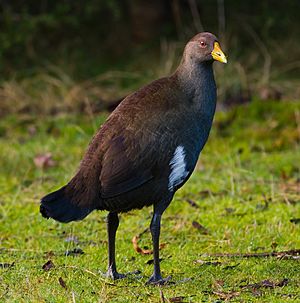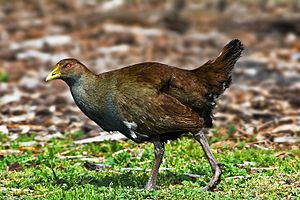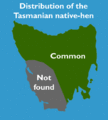Tasmanian nativehen facts for kids
Quick facts for kids Tasmanian native hen |
|
|---|---|
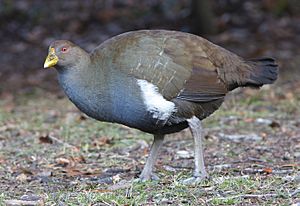 |
|
| at Mt Field National Park | |
| Conservation status | |
| Scientific classification | |
| Genus: |
Tribonyx
|
| Species: |
mortierii
|
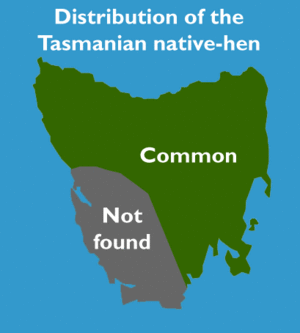 |
|
| Tasmanian native hen distribution | |
| Synonyms | |
|
Gallinula mortierii |
|
The Tasmanian native hen (Tribonyx mortierii) is a special bird that cannot fly. It belongs to a group of birds called rails. This bird is one of twelve types of birds that live only on the Australian island of Tasmania.
Many birds that cannot fly have disappeared because of humans. But the Tasmanian native hen has actually done well since European farming started in Tasmania.
Contents
What's in a Name?
This bird was first named Tribonyx mortierii in 1840. It was named after a person called Barthélemy Charles Joseph Dumortier.
People call this bird by different names. Most experts call it the Tasmanian native hen. Some special books use Tasmanian nativehen. Other fun names for it are narkie, waterhen, and turbo chook!
What Does the Tasmanian Native Hen Look Like?
The Tasmanian native hen is a strong, flightless bird. It is about 43 to 51 centimeters (17 to 20 inches) long. Its back is olive brown, and it has a white patch on its side. Its belly is darker and looks a bit bluish-grey.
Its short tail is almost black and usually stands straight up. The bird has thick, strong legs with grey, scaly skin and sharp claws. Its eyes are a bright red color. The beak is greenish-yellow and has a small shield-like part on its forehead.
Young Native Hens
Young native hens look a lot like the adults. But their colors are not as bright. Their bellies have small white spots. Their beaks are greenish-yellow, and their eyes are bright red, just like the adults.
Male birds usually have longer beaks and legs. However, it's hard to tell males and females apart just by looking at them.
Where Do Tasmanian Native Hens Live?
The Tasmanian native hen stays in one place. It likes open, grassy areas that are close to water. You can find it all over Tasmania, except in the far west and southwest.
It does not live on King or Flinders Islands in Bass Strait. But a group of these birds was brought to Maria Island, and they are now living well there. You can often see them near water bodies with grassy edges.
A Look Back in Time
Fossils show that the Tasmanian native hen used to live on the main Australian landmass. This was about 4,700 years ago. Scientists think it disappeared from the mainland because of the dingo. Another idea is that a very dry period caused them to die out there.
How Do Tasmanian Native Hens Live Together?

Tasmanian native hens live in groups of two to five birds. Young birds from the year before often stay with the group. They help take care of the new chicks. After about a year, these young birds leave to find their own homes.
Since they don't move much, these groups have clear territories. These areas can be up to 5 acres (2 hectares) big. They protect their territory strongly with calls and displays. Sometimes, they even fight! Birds will jump, peck, and kick each other. This can sometimes cause them to bleed or lose feathers.
Family Life and Reproduction
Each group usually has one female who lays eggs. She mates with all the males in her group. This kind of family structure, where groups stay together, is not common in many other bird species. Scientists think it might be because more male chicks are born than female chicks.
Sounds They Make
The Tasmanian native hen has 14 different calls. These range from soft grunts to loud alarm calls. They also have a special "see-sawing" duet. This call starts quietly and gets louder, ending in harsh screeching sounds. They even call at night!
How Fast Can They Run?
Even though they can't fly, these birds can run very fast. They have been recorded running up to 48 kilometers per hour (30 miles per hour). When they run fast, they use their wings to help them balance.
Breeding and Life Cycle
The breeding season starts between July and September. This depends on how much rain there is and how much food is available. Birds usually breed once a year. But if there is a lot of food, they might have two groups of chicks.
The nest is a simple, flat mat of grass. It is built among taller grasses, usually near water or on wet ground. A female lays five to eight oval eggs. The eggs are about 56 by 38 millimeters (2.2 by 1.5 inches). They are a dull yellow, buff, or brown color with some reddish-brown and lavender spots.
Besides the main nest, they build other "nursery nests." These are used for sleeping with the chicks at night. They also serve as hiding spots if predators are nearby. Baby chicks are covered in soft, dark brown fluff.
What Do They Eat?
Tasmanian native hens mostly eat grass shoots and the leaves of small plants. They graze on these during the day. They also eat insects, seeds, and fruit from orchards.
Farmers sometimes think these birds cause damage to their crops. However, studies in the 1960s showed that rabbits caused more damage than the native hens. Many of the farmers' worries about crop damage were found to be caused by other animals.
The Tasmanian native hen is a "secondary grazer." This means it needs other animals to keep the grass short so new shoots can grow. Before Europeans arrived in Tasmania, Indigenous people would burn grasslands. This created open areas for animals to eat, which they would then hunt. When more grassy areas were created by farming, and rabbits were introduced, it gave the native hens more food. This helped their numbers grow.
Protecting the Tasmanian Native Hen
The Tasmanian native hen is currently listed as a species of "least concern" by the IUCN. This means there are many of them, and their numbers are not dropping much.
However, there is a worry about the red fox possibly coming to Tasmania. Red foxes could harm the native hen and other animals.
Since August 15, 2007, the Tasmanian native hen has been protected by Tasmanian laws. Before this, it was one of only four native birds in Tasmania that had no legal protection outside of national parks. Now, most native Tasmanian birds are protected.
Images for kids
See also
 In Spanish: Gallineta de Tasmania para niños
In Spanish: Gallineta de Tasmania para niños



